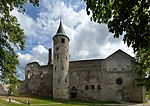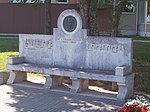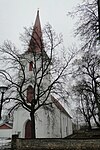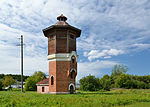Haapsalu
| Haapsalu | |||
|
|||
| State : |
|
||
| Circle : |
|
||
| Coordinates : | 58 ° 57 ' N , 23 ° 32' E | ||
| Height : | 10 m | ||
| Area : | 263.99 km² | ||
| Residents : | 13,596 (2017) | ||
| Population density : | 52 inhabitants per km² | ||
| Time zone : | EET (UTC + 2) | ||
| Telephone code : | (+372) 047 | ||
| Postal code : | 90502-90507 | ||
| Community type: | Borough | ||
| Structure : | 1 city, 2 large villages, 56 villages | ||
| Mayor : | Urmas Sukles | ||
| Postal address : | Posti 34 90504 Haapsalu |
||
| Website : | |||

|
|||
Haapsalu ( German and Swedish Hapsal , Finnish also Haapsalo or Haapasalo ; Russian Хаапсалу , Гапсаль ) is a city in Estonia .
geography
Haapsalu is located on the west coast of Estonia and, like Pärnu, is a health resort with a mild climate. Because of its many waterways, the city in Estonia is also called the “ Venice of the North” or “Venice on the Baltic Sea ”.
history
The city was founded between 1260 and 1270. It goes back to the seat of the diocese of Ösel-Wiek founded here under his bishop Hermann II of Buxhoeveden (1230–1285). It was first mentioned in a document in 1279, when the place then called Hapsal became the center of the diocese for 300 years. The impressive bishop's castle , located on an artificial hill, surrounded by an 803 m long wall and preserved as a ruin, is still a reminder of this time.

When the bishopric moved to Arensburg ( Kuressaare in Estonian ), the city lost more and more of its importance. This development did not end until the beginning of the 19th century. The Baltic German doctor Carl Abraham Hunnius discovered the healing properties of the Haapsalu mud, founded the first sanatorium in 1825 and quickly established the city as a fashionable health resort. Seaside bathing houses and mud baths were built. The Russian tsar Romanov family valued the spa town, which in the past, as now, attracts many Estonian and foreign visitors, especially in summer.
In 2017 the rural community of Ridala was incorporated into Haapsalu. As a result, Haapsalu increased by an area of 253 km², but only by around three and a half thousand inhabitants. In addition to the actual city of Haapsalu with over 11,000 inhabitants on 10.59 km², the municipality of Haapsalu now also consists of two large villages ( Paralepa and Uuemõisa ) and 56 villages.
| year | 1934 | 1959 | 1970 | 1979 | 1989 | 2004 | 2014 | 2017 (1) | 2017 (2) | 2018 |
|---|---|---|---|---|---|---|---|---|---|---|
| Residents | 4,649 | 8,567 | 11,483 | 13,035 | 13,035 | 11,876 | 10,316 | 9,946 | 13.210 | 13,142 |
| Figures 2017 before (1) and after (2) the reorganization of the municipalities | ||||||||||
politics
City council
The city council is elected for four years and consists of 25 members. After the local elections in Estonia in 2017 , Jaanus Karilaid ( Estonian Center Party ) became chairman of the city council.
Mayor of the city is Urmas Sukles (non-party).
Town twinning
Haapsalu maintains city partnerships with
-
 Rendsburg in Germany (since 1989)
Rendsburg in Germany (since 1989) -
 Eskilstuna in Sweden
Eskilstuna in Sweden -
 Fundão in Portugal (since 2004)
Fundão in Portugal (since 2004) -
 Greve in Chianti in Italy
Greve in Chianti in Italy -
 Haninge in Sweden
Haninge in Sweden -
 Hanko in Finland
Hanko in Finland -
 Uman in Ukraine
Uman in Ukraine -
 Bethlehem in the Palestinian Territories
Bethlehem in the Palestinian Territories -
 Ikšķile in Latvia
Ikšķile in Latvia
Culture and sights
The cultural life in Haapsalu awakens in summer. Then several festivals take place in the coastal town.
Buildings
The main attractions are the bishop's palace, the promenade ( Promenaad ), where artists such as Pyotr Ilyich Tchaikovsky and the painter Nikolai Roerich strolled, and the Kursaal ( Kuursaal , built in 1898).
Haapsalu is rich in Art Nouveau villas, which are gradually being restored. Probably the oldest surviving monument to Friedrich Schiller has been in the town's Läänemaa Museum since 1957 . It was built in 1813 on the nearby Puhtu peninsula (German Pucht ) by Dorothea Augusta von Rosen (1781-1826), an acquaintance of Schiller's wife.
Bishop's castle of the bishops of Ösel-Wiek
railroad
At the time of its construction, Haapsalu station had the longest covered platform in Europe at 214 m . The train station, built in 1907 by the St. Petersburg architect Verheim, is now only a monument and museum. It formed the end point of the railway line opened in 1905 from Keila near the capital Tallinn to Haapsalu. The railway project, realized with the support of the Tsar, reflects the importance of the town as a health resort at the time. After Estonia gained independence in 1991, tourism was developed again, but rail links were no longer promoted. The Riisipere- Haapsalu section was closed to passenger traffic in 1995 due to protests from the population and dismantled in 2004. Historical locomotives and wagons are now on the tracks that remained in the station area, and a railway museum is housed in part of the station .
From the railway museum there is an approx. 50 km long cycle path on the former railway line to Riisipere , where there is a train connection to Tallinn . The cycle path is an EU investment and opens up the long stretch between Tallinn and Haapsalu for cycle tourists.
Soviet steam locomotive L-1646 of the SŽD series Л, built in 1951 in the Railway Museum
Say of the White Lady
The legend of the White Lady tells that once a canon fell in love with a girl and smuggled her into the bishop's palace disguised as a choirboy . When the liaison was discovered, the canon was thrown into the dungeon, where he starved to death while the girl was walled up alive in the wall of the church that was being built. Since then, on nights of full moon in August, a glaring shadow has appeared in the middle window that resembles the outlines of a woman's figure. The festival “Time of the White Lady” ( Valge daami aeg ) takes place annually at this time .
Lindenhof
Lindenhof or Linden (Estonian Ungru) is located about 5 kilometers southwest of the city center of Haapsalu. The estate was first mentioned in 1523. Today you can only see the ruins of Ungru Castle.
Regular events
- Early Music Festival
- Violin Festival Viiulimängud
- Pyotr Tchaikovsky Music Festival
- August Blues Festival (Augustibluus)
- Valge daami aeg
Personalities
sons and daughters of the town
- Evert Horn (1585-1615), Swedish field marshal
- Gustav Adolph Oldekop (1755–1838), poet
- Friedrich von Löwis of Menar (1767–1824), Russian Imperial Lieutenant General, Land Marshal of Livonia
- Paul von Prittwitz (1791–1856), Imperial Russian Lieutenant General and Senator
- Prince Alexander Gorchakov (1798–1883), Russian diplomat, foreign minister and chancellor
- Ferdinand Wiedemann (1805–1887), Baltic German linguist
- Jacques Rosenbaum (1878–1944), architect
- Nikolai Vekšin (1887–1951), sailor
- Hedwig Büll (1887–1981), Baltic German missionary
- Fred von Hoerschelmann (1901–1976), Baltic German radio play author
- Andres Põder (* 1949), Lutheran theologian, Archbishop of Tallinn
- Leili Pärnpuu (* 1950), chess player
- Andres Lipstok (* 1957), economist and politician
- Heiki Kranich (* 1961), politician
- Heidi Rohi (* 1966), fencer
- Kaido Kaaberma (* 1968), fencer
- Urve Palo (* 1972), politician
- Nikolai Novosjolov (* 1980), fencer
- Eda-Ines Etti (* 1981), singer
- Kaia Kanepi (* 1985), tennis player
- Kristina Kuusk (* 1985), fencer
Other personalities associated with Haapsalu
- Ilon Wikland (* 1930), born in Tartu , emigrated to Sweden , children's book illustrator
- Pyotr Ilyich Tchaikovsky is said to have written his 6th symphony in his summer house in Haapsalu.
Web links
Individual evidence
- ^ Haapsalu website , accessed October 17, 2018
















